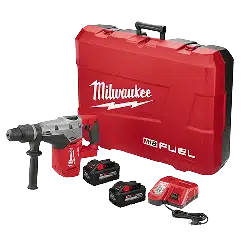Loading ...
Loading ...
Loading ...

5
Operating
Position the tool, grasp the handles rmly and pull
the trigger. Always hold the tool securely using both
handles to maintain control. This tool has been de-
signed to achieve top performance with only moder-
ate pressure. Let the tool do the work.
If the speed begins to drop o when drilling large or
deep holes, pull the bit partially out of the hole while
the tool is running to help clear dust. Do not use water
to settle the dust since it will clog the bit utes and
tend to make the bit bind in the hole. If the bit should
bind, a built-in, non-adjustable slip clutch prevents
the bit from turning. If this occurs, stop the tool, free
the bit and begin again.
Cold Starting
If this tool is stored for a long period of time or
at cold temperatures, it may not hammer ini-
tially because the lubrication has become stiff.
To warm up the tool:
1. Insert and lock a bit or chisel into the tool.
2. Pull the trigger and apply force to the bit or chisel
against a concrete or wood surface for a few
seconds. Release the trigger
3. Repeat until the tool starts hammering. The colder
the tool is, the longer it will take to warm up.
Using Rotary Percussion Core Bits
Core Bits are useful for drilling large or long holes
in concrete. MILWAUKEE Heavy-Duty Core Bits
have heat-treated steel bodies with durable carbide
tips. These core bits are specially designed for fast,
accurate drilling with combined hammering and
rotary action.
1. Clean and lubricate the
threads on the adapter
and core bit to make
later removal easier.
Thread the adapter
shank to the rear of the
core bit.
2. Push the guide plate
onto the pointed end of
the center pin. Insert the
center pin and guide
plate assembly into the
core bit. Be sure the
small end of the center
pin is securely placed
into the hole in the cen-
ter of the core bit.
For LHS systems, screw
the threaded end of the
centering bit into the core bit.
NOTE: If using an extension, first thread the
adapter shank to the extension. Then thread the
core bit to the extension.
3. Insert the adapter into the nose of the tool as
described in “Installing Bits and Chisels”. Set the
knob to the "hammering with rotation" setting.
4. Press the centering bit
rmly against your cen-
ter mark, hold the tool
rmly and pull the trig-
ger.
NOTE: If the
48-20-5099 threaded
stud is used, or a cen-
ter pin and guide plate
are not available, use
a template or notched
board to start the hole.
5. Start the tool. After drill-
ing to about the depth
of the core bit teeth,
remove the center pin
and guide plate from
the core bit (not nece-
sary for LHS system).
Resume drilling.
6. To change the core bit, hold the tool upwards,
pointing it away from your body, and run it briey
in forward to loosen the core bit from the adapter.
NOTE: To make deeper holes, remove the core bit,
break and remove the core, then resume drilling.
When drilling long or deep holes, after each inch
of penetration pull the bit partially out of the hole
while the tool is running, to help clear dust from
the bit utes. Dust can clog the bit utes and can
make the bit bind in the hole. If this occurs, stop
the tool, free the bit and begin again.
Drilling Large Diameter Holes
with Core Bits
When drilling holes with large diameter core bits,
dust may build up in the cut and can cause the tool
to stall, bind, or cut slowly. By creating an opening
for the dust to escape, drilling time, bit stress, and
tool stress can be reduced.
1. Start the cut as normal.
2. Once the bit is rmly established in
Cut
approximately
1/4" deep with
a core bit.
Drill a hole
through the
work.
Dust and debris
will fall through
the hole.
Top view
Cut
approximately
1/4" deep with
a core bit.
Drill a hole
through the
work.
Dust and debris
will fall through
the hole.
Top view
Cut
approximately
1/4" deep with
a core bit.
Drill a hole
through the
work.
Dust and debris
will fall through
the hole.
Top view
the hole.
Dust and debris
will fall through
the cut (about 1/4" deep), remove
the bit from the cut.
3. Remove the bit from the tool.
4. Install a standard uted bit, ap-
proximately 7/8" in diameter, onto
the tool.
5. Drill a perpendicular hole through
the kerf of the large hole.
• Depending on the location of the
work, the hole should either break
through the other side of the hole/
oor or extend 4"-5" past the end
of the workpiece (such as into the
dirt below a concrete slab).
• If dust builds up in the hole,vacuum
it out and continue drilling.
• If drilling through a wall, the hole
for dust should be drilled on the
Side vie
w
of slab
lowest part of the large hole
kerf as the dust will fall there
when drilling and can be
evacuated more easily.
6. Reinstall the core bit and con-
tinue drilling. Dust and debris
will fall through the hole and
optimize the cutting ability of
the bit.
Loading ...
Loading ...
Loading ...
